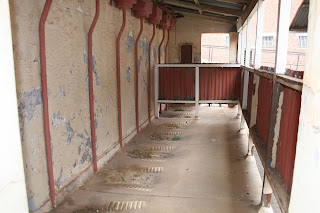We visited caves renowned as the "Cradle of Humankind." They are called that because the oldest fossils of mammals that humans descended from were found here. We enjoyed our time walking deep down into the earth and crouching as we walked through the narrow passages.
Friday, January 30, 2009
Apartheid Museum
One of Afrikaaner professors who speaks to us told us that she believes that every South African should visit the Apartheid museum in Johannesburg. It is an incredibly powerful collection of the contributing factors to Apartheid, the realities of Apartheid and the countries to journey to democracy. Through interviews, tapes of life footage and a many write-ups and pictures the museum paints a vivid picture of what it was like to live during the Apartheid era.
This picture demonstrates the inconsistent nature of the apartheid racial classifcation system
This picture demonstrates the inconsistent nature of the apartheid racial classifcation system
Constitution Hill
We spent one morning visiting Constitution Hill - the former home of a prison and the current home of the South African Constitutional Courts. Constitution Hill is a difficult place to be. As the tour guide walks you around the prison the reality of life under apartheid becomes vividly apparent - to the point you can almost smell what it would be like to live with 35 other people in an incredibly small room that contained both bathroom "pots" and "beds" composed of folded blankets. It is heart-breaking and a points nauseating to hear of the cruelty that people have inflicted upon each other. That one person could treat another person in these ways is fairly incomprehensible -- the only answer to the questions of "how" and "why" seems to be "evil."
A glimpse of South Africa
By Becca Letkeman
"See Soweto and you see all of South Africa," a lady tells me as we stand beside a fruit stand on one of the city's busy streets. If the city was a choir it's sopranoes would be blaring Kombi (VW vans) horns, it's altos the mellow hum of constant chatter between neighbours and friends, tenors the cheerful bits of pulsing pop music, and bases the lulling chug of PUTCO buses.
Soweto is bustling.
Soweto is vibrant.
Soweto is full of life.
I cannot completely describe what it is like to be here, nor capture the warmth and openness of the people who live here. We walk down the street and people smile, wave, or stop to talk, which prompts us to attempt 'Sawabona' (a Zulu greeting). They laugh heartily, surprised and amused by our attempts at Zulu. Then they reply, 'Unjani?' (How are you?) 'Ngiyaphila,' (I am fine). The conversation stops here because we do not know much of the language beyond the greetings!
I have been struck by the welcome people give us. On Monday we went to SKY (Soweto Kliptown Youth), a youth center which teaches gumboot dancing, a form of South African dancing orginating in the mines. Before we watched the children dance they mentions several times, 'You are at home here. This is home.' We'd never been there before!
From this gesture and others I've gathered that those from Soweto know a lot about care.
It seems Sowetans know a lot about GOD.
And after catching such wide glimpses of GOD in Soweto, if it indeed speaks for the whole of South Africa, discovering the rest of the country will hopefully be a rich and challenging journey.
"See Soweto and you see all of South Africa," a lady tells me as we stand beside a fruit stand on one of the city's busy streets. If the city was a choir it's sopranoes would be blaring Kombi (VW vans) horns, it's altos the mellow hum of constant chatter between neighbours and friends, tenors the cheerful bits of pulsing pop music, and bases the lulling chug of PUTCO buses.
Soweto is bustling.
Soweto is vibrant.
Soweto is full of life.
I cannot completely describe what it is like to be here, nor capture the warmth and openness of the people who live here. We walk down the street and people smile, wave, or stop to talk, which prompts us to attempt 'Sawabona' (a Zulu greeting). They laugh heartily, surprised and amused by our attempts at Zulu. Then they reply, 'Unjani?' (How are you?) 'Ngiyaphila,' (I am fine). The conversation stops here because we do not know much of the language beyond the greetings!
I have been struck by the welcome people give us. On Monday we went to SKY (Soweto Kliptown Youth), a youth center which teaches gumboot dancing, a form of South African dancing orginating in the mines. Before we watched the children dance they mentions several times, 'You are at home here. This is home.' We'd never been there before!
From this gesture and others I've gathered that those from Soweto know a lot about care.
It seems Sowetans know a lot about GOD.
And after catching such wide glimpses of GOD in Soweto, if it indeed speaks for the whole of South Africa, discovering the rest of the country will hopefully be a rich and challenging journey.
Regina Mundi Church
As part of our touring we visited the Regina Mundi Church. During the Apartheid era this church was a rallying point for protesters. It is particularly infamous because of the destruction cause by the South African police when they raided the church, causing significant destruction, including shooting the hands off of a statue of Jesus. The church also houses a picture of a black Madonna and a beautiful picture called the "eye of Soweto."
The second floor of the church is filled with pictures and personal reflections on the affects of apartheid and how people have journeyed through that time.
The second floor of the church is filled with pictures and personal reflections on the affects of apartheid and how people have journeyed through that time.
Subscribe to:
Comments (Atom)









































